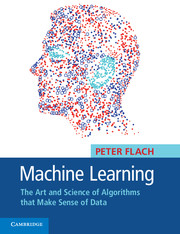Book contents
- Frontmatter
- Contents
- Preface
- Prologue: A machine learning sampler
- 1 The ingredients of machine learning
- 2 Binary classification and related tasks
- 3 Beyond binary classification
- 4 Concept learning
- 5 Tree models
- 6 Rule models
- 7 Linear models
- 8 Distance-based models
- 9 Probabilistic models
- 10 Features
- 11 Model ensembles
- 12 Machine learning experiments
- Epilogue: Where to go from here
- Important points to remember
- References
- Index
2 - Binary classification and related tasks
Published online by Cambridge University Press: 05 November 2012
- Frontmatter
- Contents
- Preface
- Prologue: A machine learning sampler
- 1 The ingredients of machine learning
- 2 Binary classification and related tasks
- 3 Beyond binary classification
- 4 Concept learning
- 5 Tree models
- 6 Rule models
- 7 Linear models
- 8 Distance-based models
- 9 Probabilistic models
- 10 Features
- 11 Model ensembles
- 12 Machine learning experiments
- Epilogue: Where to go from here
- Important points to remember
- References
- Index
Summary
IN THIS CHAPTER and the next we take a bird's-eye view of the wide range of different tasks that can be solved with machine learning techniques. ‘Task’ here refers to whatever it is that machine learning is intended to improve performance of (recall the definition of machine learning on p.3), for example, e-mail spam recognition. Since this is a classification task, we need to learn an appropriate classifier from training data. Many different types of classifiers exist: linear classifiers, Bayesian classifiers, distancebased classifiers, to name a few. We will refer to these different types as models; they are the subject of Chapters 4–9. Classification is just one of a range of possible tasks for which we can learn a model: other tasks that will pass the review in this chapter are class probability estimation and ranking. In the next chapter we will discuss regression, clustering and descriptive modelling. For each of these tasks we will discuss what it is, what variants exist, how performance at the task could be assessed, and how it relates to other tasks. We will start with some general notation that is used in this chapter and throughout the book (see Background 2.1 for the relevant mathematical concepts).
The objects of interest in machine learning are usually referred to as instances. The set of all possible instances is called the instance space, denoted in this book.
- Type
- Chapter
- Information
- Machine LearningThe Art and Science of Algorithms that Make Sense of Data, pp. 49 - 80Publisher: Cambridge University PressPrint publication year: 2012

